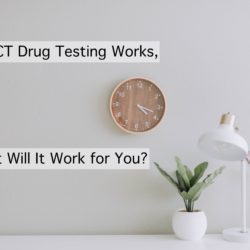This information is provided for educational purposes only. Reader retains full responsibility for the use of the information contained herein.
There are two types of drug tests: lab-based tests and point-of-care (POCT) or rapid-result tests. There are various specimens that can be used for drug tests, different collection methods, and a myriad of procedures that can be employed, but just two types of tests.
Testing Methods
For many years, lab-based urine testing conducted at a laboratory certified by the Substance Abuse and Mental Health Services Administration (SAMHSA) has been the gold standard. But in October 2019, SAMHSA issued final mandatory guidelines for lab-based oral fluid testing and in 2020 the agency issued a notice of proposed rulemaking (NPRM) for hair testing.
So, now there are three drug testing methods that have been endorsed by the federal government—lab-based urine, oral fluid and hair. There are other bodily specimens that can be used to detect drugs, but they are largely unproven, lack a legal track record and, in some cases, require the collection of a urine, oral fluid or hair sample to confirm a presumptive positive at a laboratory.
Lab-based or POCT?
Lab-based drug testing utilizing procedures developed by the federal government and using urine, oral fluid or hair as the test sample is the most legally defensible way to conduct workplace drug testing. And in today’s legal-marijuana, litigiously oriented environment, sticking to one of these three drug testing methods is a smart decision… most of the time. There are circumstances in which a testing method that yields an instant positive or negative result is needed to facilitate making fast hiring or disciplinary decisions.
Settling on a name for rapid-result testing is almost as challenging as finding the right device for you. This testing method is sometimes referred to as point-of-care or point-of-collection testing (the acronym POCT is commonly used). Other names include on-site, instant, instant-result, rapid and, of course, rapid-result testing.
For drug testing purposes, a POCT device is a single-use, disposable test that produces a result within minutes. The result is usually a qualitative, positive or negative result, meaning it indicates whether or not there are drugs in the system of the person being tested above or below a designated cut-off level. However, POCT devices do not yield quantitative results, the specific level of drugs in the person’s system measured in nanogram per milliliter (ng/mL). There are both oral fluid and urine POCT devices, but not hair.
Lab-based drug test results are usually available within 24 hours if the result is negative or 48-72 hours if the result is positive. POCT devices are ideal for circumstances when an employer cannot wait 1-3 days to get the result. For instance, because the vast majority of all drug tests are negative, especially in the case of pre-employment testing, a POCT negative result means an employer can offer an applicant a job immediately rather than possibly losing out on hiring the ideal candidate while waiting for a lab result.
Also, POCT devices are a good match for remote workplaces and businesses with around-the-clock work shifts when traditional off-site collection facilities are not available or are cost prohibitive. POCT oral fluid testing is especially ideal in these situations because the collection process is so much easier than a urine collection and it does not always require the services of a professional technician.
The three most important questions to ask when considering POCT for the workplace are: 1) Is it legal?, 2) Is it accurate?, and 3) Does it work?
Is It Legal?
Generally speaking, yes, POCT in the workplace is legal but not in every state. There are some states that have specialty laws that only permit lab-based testing. Alabama is an example of a state that offers employers a discount on their workers’ compensation premiums if they will test in accordance with guidelines provided by the state. One of those guidelines is that all initial screen and confirmation testing must take place at a laboratory. Outside of Alabama’s voluntary program, POCT is permitted. Florida also has a voluntary workers’ compensation discount law, except POCT is allowed as long as the employer uses an FDA-cleared device and POCT positives are confirmed at a laboratory.
Most states allow employers to move to deny workers’ and/or unemployment compensation benefits to an individual who tests positive for drugs or alcohol. In some cases, those laws contain very specific drug testing requirements. Alabama, for example, only permits lab-based urine testing as part of its workers’ compensation law. Alaska, on the other hands, permits the use of POCT devices that are FDA cleared and all positive results must be confirmed at a lab.
Check all applicable state laws to confirm that POCT devices are permitted in each of the states where you have business operations. (Note: U.S. Dept. of Transportation drug and alcohol testing regulations only permit lab-based testing.)
Is It Accurate?
Many years ago, the accuracy of POCT devices was a hot topic. Only a small number of urine POCT devices had proven themselves worthy of employers’ trust. Today there are many devices on the market, including oral fluid devices, which provide employers with viable options.
Here are few key considerations related to accuracy that you should consider when researching POCT devices:
- Ask to review a device’s package insert (PI), which will contain a lot of useful information, including the device’s sensitivity (true positive) and specificity (true negative) performance levels. The higher the percentages, the better. For example, if a device has a sensitivity level of 97%, it means that it correctly identifies a positive result 97% of the time or, conversely, it has a 3% false negative rate.
- Look for a device that is FDA cleared. Some state laws require employers to use FDA-cleared POCT devices.
- Look for a product that offers cutoff levels that are equivalent to lab initial screen cut-off levels.
- Remember, as well, that accuracy varies by the drug, so which drugs are being tested for with the device is another important factor to consider. Most manufacturers offer a wide variety of drug test panels, but their cut-off levels may vary. So read the fine print carefully.
Does It Work?
Does POCT work? That’s the proverbial $64,000 question. And the answer depends on what you hope to achieve by using a POCT device. Three common objectives for using a POCT device are convenience, cost, and expediency in making employment-related decisions. But a rapid-result that saves money by eliminating the use of a professional collector is only as good as the accuracy of the result.
To increase the legal defensibility of a POCT program, use an FDA-cleared device, stick to urine or oral fluid, confirm all initial screen positive results at a certified laboratory before taking adverse employment action, and use a Medical Review Officer (MRO) to verify all confirmed positive results.
In the final analysis, POCT works if it works for you, meaning it has to fit your company culture, align with your drug testing objectives, and produce results that you can feel confident about if your program is ever legally challenged.



